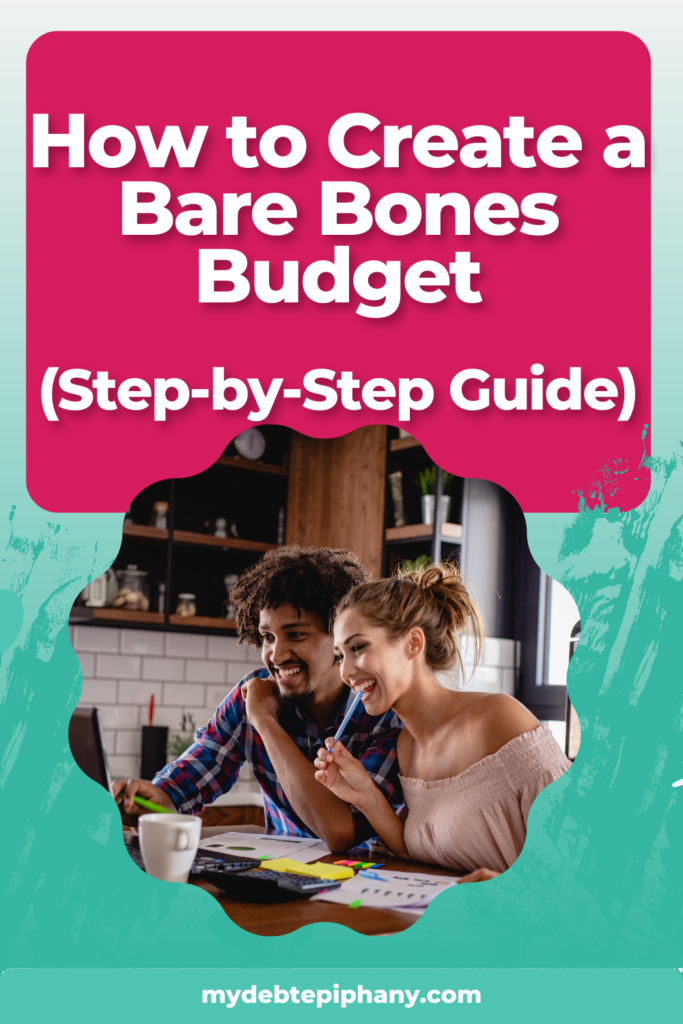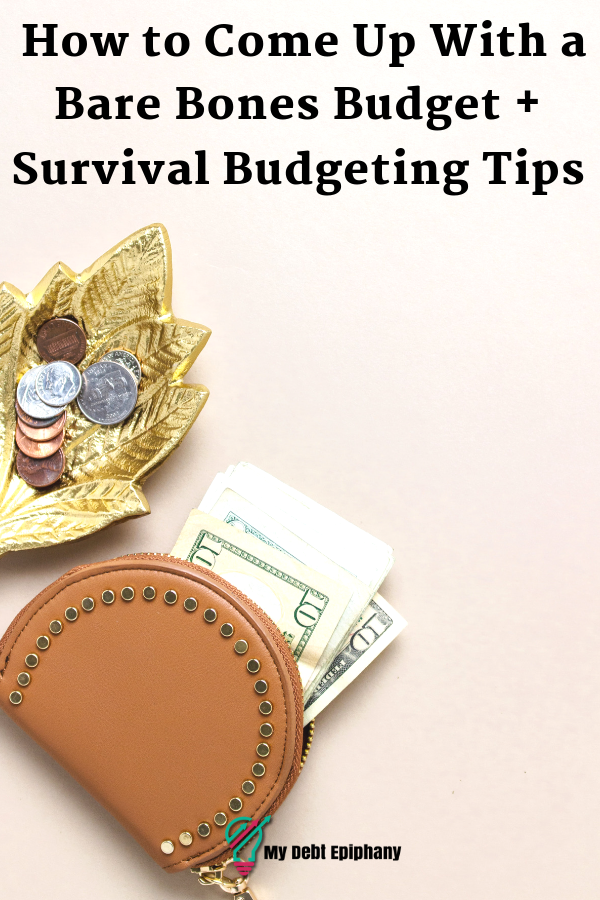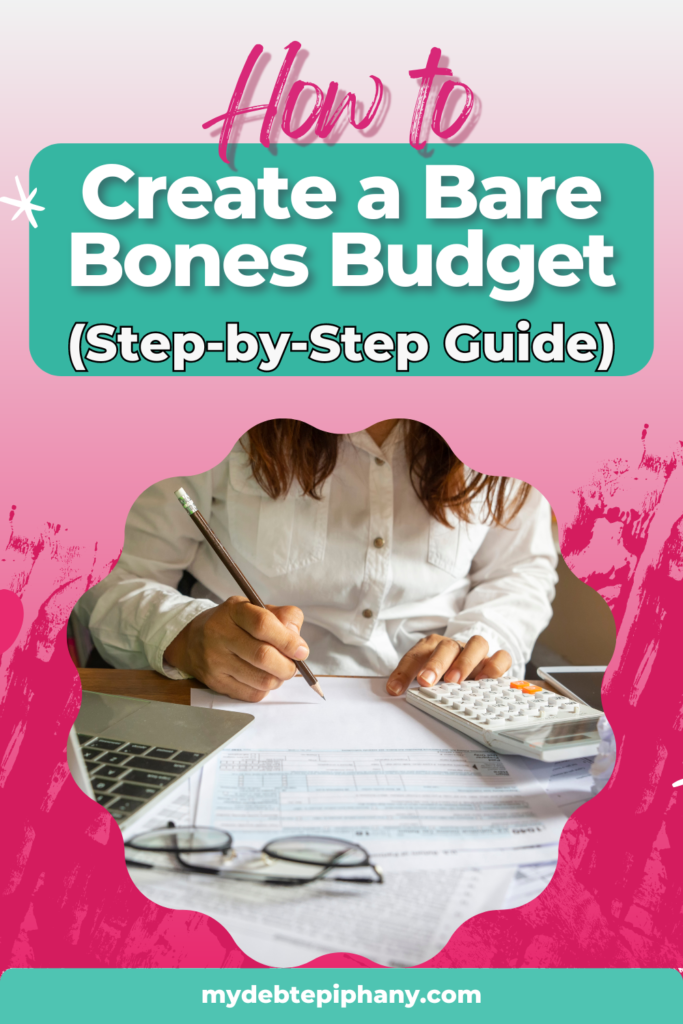How to Come Up With a Bare Bones Budget
Do you ever wonder how much it truly takes for you to live each month? Sure, you might have a rough budget in place, but do you truly know how much money you’d need just to cover your basic living expenses.
It’s one thing to budget, but a general budget includes basic monthly expenses along with categories like savings, debt payments, and personal wants. When you have a financial hardship or money is tight, you can rely on a bare bones budget to help you get through.
A bare bones budget can even be a great way to help you strip down your expenses so you can focus on paying off more debt or maximizing your savings.
Table of Contents
So What is a Bare Bones Budget?
A bare bones budget is different from your regular monthly budget. It basically includes your core non-negotiable monthly expenses. These are costs that you need to pay each month no matter what.
When you really think about it, some of the expenses in your budget aren’t necessary for survival. If you suddenly lost your job or endured a medical crisis that put you out of work, would you really be thinking about your gym membership and your morning Starbucks run?
Or would you be thinking about how you’re going to cover your bills and pay your rent or mortgage?
It’s best to set up a bare bones budget before you actually need it. If you have a month where money is tight, you can easily pull it out and start using it.
3 Key Reasons to Create One

Learn How Much You Can Really Live on
When I first created my bare bones budget, I was shocked at how little my family could actually live on each month if we had to. Having a ton of monthly expenses can put a lot of pressure on anyone. This can make you feel like you have to stay stuck in a job you don’t like or put up with other situations that burden.
A bare bones budget can help lower your stress levels during tough times as it will help you drop your expenses significantly.
Set a Baseline For Building Your Emergency Fund
Your emergency fund should include several months of basic expenses to serve as a cash cushion when unexpected costs arise. If you spend $4,000 per month, saving a 6-month emergency fund with a balance of $24,000 can seem overwhelming.
When you really think about it, your spending should decrease in the event of an emergency. You likely won’t be dining out as often as you do now and paying for other costs. You may even find a way to make a little extra cash to help supplement some of your expenses.
This is why it’s helpful to base your emergency fund off your bare bones budget. If you spend $4,000 monthly bare bones budget is actually $2,500, you’ll find it easier to save the $15,000 you need to cover six months of base expenses.
Related: Emergency Fund Tips: How to Grow Your Account Fast and Where to Start
Build an Emergency Fund Fast Masterclass
Be Prepared For the Unexpected
Using a bare bones budget isn’t fun, but sometimes it’s necessary. Whether you are trying to get through an income loss situation or throw every spare penny toward debt, a bare bones budget will help you stay in survival mode so you can actually make progress with your finances.
Getting Started
Now that we know why having a bare bones budget is so important, let’s talk about some easy ways to get started and come up with a bare bones budget ASAP.
Find Out Where Your Money is Going
Having a budget is one thing, but knowing exactly where your money is going is another. Take the time to track your spending over the past few months. You can do this by using an online system like Mint, utilizing your bank statements, or doing it by hand.
I have a written budget and I do weekly check-ins with myself so I often make it a priority to track my spending and record how much certain budgeted items actually cost.
Choose Your Necessity Expenses
To come up with a bare bones budget, you must first choose the non-negotiable expenses that you need to survive. If your current budget has become the standard, it may seem difficult to think about cutting things out.
You may already feel like you’re being frugal and living comfortably with your current numbers. But remember, a bare bones budget is more of an emergency tool that you will use to help you get by. So naturally, it will make you a little uncomfortable.
Picture a hypothetical situation where your income is slashed and/or you’re facing a pretty large expense. You may very well need to cut your expenses and revert to a bare bones budget. Which expenses do you think about first? What can’t you put on hold or do without?
Those are likely your necessary expenses but just to make sure, here’s an example of what mine are.
- Mortgage payment
- Utilities
- Groceries
- Insurance payments (medical, dental, auto)
- Personal care (toiletries and other hygiene care)
- Food for pets
- Gas – just enough to get to necessary places
- Internet (Personally, I don’t include this as a utility but it is important because I work from home. Without the internet, I can’t make money – If I was really in a financial bind, I could get rid of my internet service and go to the library to use the free WiFi to work. However, that would involve more gas and wear on my car too)
Some other basic necessity expenses you might have include:
- Childcare, school tuition
- Medical bills or appointment copays
- Minimum debt payments
- Security system
- Phone

Cut Out Wants and Non-Necessities
As you can see, the expenses listed above are basically non-negotiables. That should tell you which costs to cut out of your bare bones budget since you can survive without them if need be.
Some common wants include expenses like:
- Entertainment
- Dining out
- Memberships and subscriptions
- Hobbies
- Vacations
- Non-essential household and personal purchases
- Clothes
- Spending allowance
- Streaming services
Once you start to cut these expenses from your budget, you’ll notice your expenses suddenly drop. Most people notice a monthly decrease by at least $1,000 which is a lot of money.
Dig Deeper
I encourage you to dig deeper when trying to come up with a bare bones budget. Get real and honest about the expenses that are non-negotiable and the other ones that can fall to the wayside when money gets really tight.
Personally, I realized we can go without when it comes to most expenses. Our minimum mortgage payment is non-negotiable, but we can lower what we spend on groceries each month by $50 if we really wanted to.
We could also consider putting my husband’s student loans into deferment in the event of a severe financial hardship. We could also lower our phone bill plans or just share one cell phone if it really came down to it.
Remember, this is a bare bones budget which means you’re free to dig deep and get creative so you can stretch your finances even more to get by and reach your aggressive goals.
Consider Your Income
Your bare bones budget won’t hold much weight if you don’t have the income to maintain it. This is why it’s important to make sure you cover all the expenses you write down.
If you have extra income left over after covering all your bare bones expenses, decide what you’ll do with it. Remember, even if your primary source of income gets cut, you can always find other opportunities to make extra money. Consider getting a side hustle or picking up a part-time gig.
If you really need the money and are willing and able to work, you can likely add an extra income stream to help you get through tough times and meet goals.
Related: Step By Step: How I Successfully Make $7,000 Per Month With My Side Hustle
20 Ways to Make Extra Money Today
How to Create Passive Income Streams on a Low Budget
Example of a Bare Bones Budget
Rent: $850
Groceries: $300
Utilities: $100
Health Insurance: $250
Personal Care/Household: $50
Pets: $35
Internet: $50
Gas/Fuel: $65
Cell Phone: $40
Total: $1,740
Ready to Create Yours?
Now that you know exactly how to come up with a bare bones budget that best fits your needs and lifestyle, it’s time to get started and create your own.
Be sure to download my free Bare Bones Budget worksheet below to help you categorize your expenses and get your alternative budget ready ASAP.
Even though a bare bones budgets may cause you to limit your spending to a point that is somewhat uncomfortable, I encourage you to think big if you ever need to start using one. Yes, you can use a bare bones budget to help you make ends meet during a tight situation.
But you can also use it as a tool to help you pay off tons of debt quickly, save large amounts of money, or even become financially independent and retire early. Use this budget as a baseline and add in a little flexibility if you wish to help you meet your goals.
Do you have a bare bones budget in place? Why or why not?







